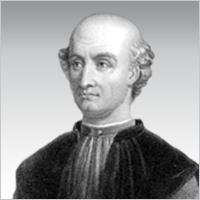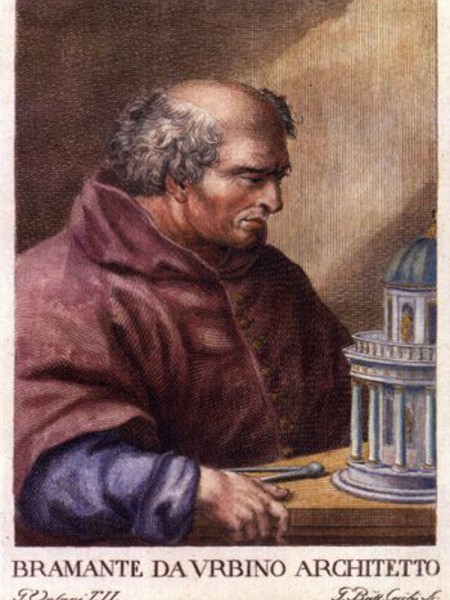Donato Bramante
Bramante ( Donato Bramante ), actually Donato di Pascuccio d' Antonio ( * 1444 in Fermignano, † March 11, 1514 in Rome ) was an Italian architect and founder of the High Renaissance architecture. From his mother's father, he was given the nickname Bramante what " The fierce seeker " means (Italian Bramare = desire ).
Life
His training as an architect, he was in Urbino by Luciano Laurana. Bramante was at the court of Montefeltro in Urbino for the first time with painting in contact. To 1476 came to Milan Bramante, 1477, he was a facade painter in Bergamo. In 1479 he stayed at the court of the Sforza in Milan, where he carried out first buildings. To Bramante in 1499 came to Rome. There he trained at the ancient ruins of the city and so developed his style gradually toward the so-called High Renaissance architecture further than their founder, he is.
Bramante met in Rome at a very fructifying artistic climate that caused the 1503 from Pope Julius II. The Pope employed alongside Bramante a number of other important artists. Among them were Giuliano da Sangallo and Michelangelo. Against both to Bramante sat through, when it came to the construction of St. Peter's from about 1504. Julius II blessed from the designs of Bramante, and so the new building was begun in 1506 under the responsibility of Bramante. When Bramante died on 11 March 1514 stood by his main work, however, not much more than the four clustered pillars, a (probably ) temporary choir and a shelter raised over the grave of Peter ( Tegurio ).
Bramante was also active as a painter. Only a few works have been preserved. His students also Michele Sammicheli belonged.
Bramante died in 1514, just one year after the death of his patron Pope Julius II
Major works
- Santa Maria presso San Satiro; 1480
- Santa Maria delle Grazie (chorus with dome ); 1492-98
- Tempietto di Bramante; 1502
- Santa Maria della Pace ( monastery courtyard with cloister ); 1504
- San Pietro in Vaticano ( St. Peter's ); from 1506
- Palazzo Caprini; 1508
- Abbey of Montecassino: Cloister of Bramante, 1595
Reception
In designed by Stephan Braunfels Marie- Elisabeth- Lüders-Haus is a so-called Bramante staircase. 1512, Pope Julius II commissioned Bramante to connect the Belvedere with the city; this staircase is located in the Museo Pio - Clementino. In contrast, the often called " Scala Bramante " designated counter spiral staircases designed to output the Vatican Museums Giuseppe Momo in 1932 actually.










